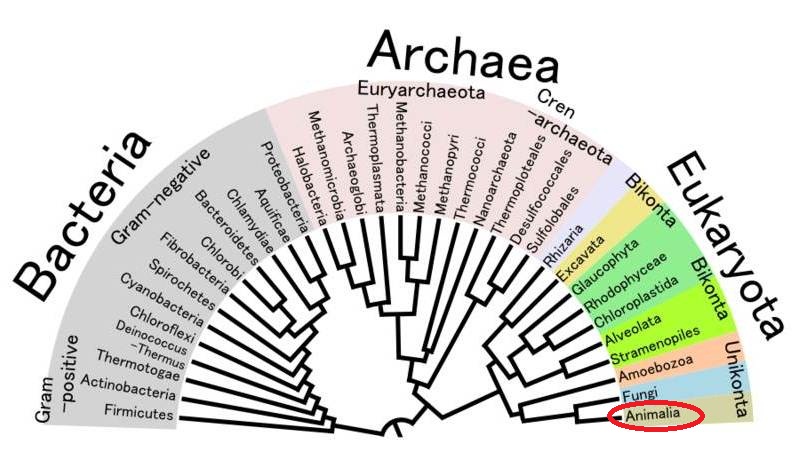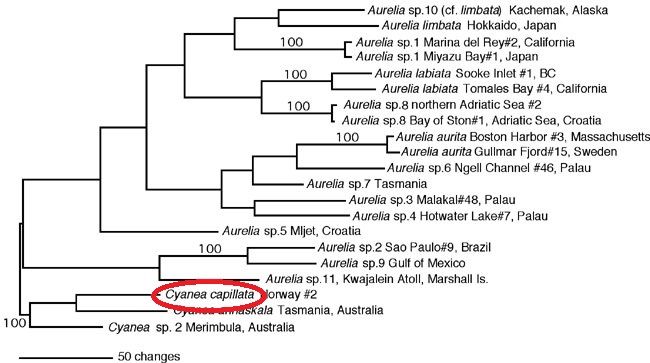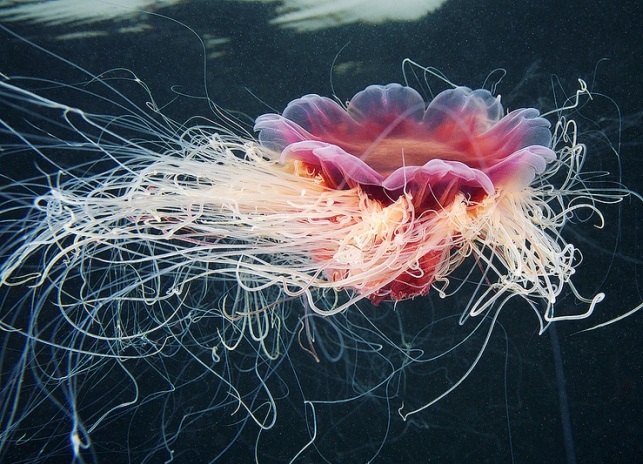 Classification
Classification
Domain: Eukarya
Kingdom: Animalia
Domain: Eukarya
Phylum: Cnidaria
Class: Scyphozoa
Order: Semaeostomeae
Family: Cyaneidae
Genus: Cyanea
Species: Cyanea capillata
This phylogenetic tree of life is coutresy of Gribaldo S. on Wikimedia Commons.
Domain Eukarya
 The Lion's Mane jellyfish is classified within the
Eukarya because it possesses a true nucleus with multiple strands of
DNA and membrane bound organelles. Another example of an
organism within the domain Eukarya is
Salvia officinalis, commonly known as sage.
The Lion's Mane jellyfish is classified within the
Eukarya because it possesses a true nucleus with multiple strands of
DNA and membrane bound organelles. Another example of an
organism within the domain Eukarya is
Salvia officinalis, commonly known as sage.
Kingdom Animalia
 The
Lion's Mane jellyfish
are in the kingdom Animalia which have several
defining characteristics: multicelluarity, non-alternation of
generation life cycle, no cell walls, and heterotrophic (does not
undergo photosynthesis). Another
example of a venomous organism under the broad kingdom of Animalia
is the
Eciton hamatum, more commonly known as the army ant.
The
Lion's Mane jellyfish
are in the kingdom Animalia which have several
defining characteristics: multicelluarity, non-alternation of
generation life cycle, no cell walls, and heterotrophic (does not
undergo photosynthesis). Another
example of a venomous organism under the broad kingdom of Animalia
is the
Eciton hamatum, more commonly known as the army ant.
Phylum Cnidaria
 The Lion's Mane jellyfish is clearly under the
phylum Cnidaria for several reasons. All Cnidarians are
diploblastic (meaning two tissues), presents radial symmetry,
have one opening as the mouth and anus, and all Cnidarians have
cnidocytes (stinging cells) that hold nematocysts. Another
example of a Cnidarians is
Chironex fleckeri, commonly known as the Box jellyfish.
If you already know about the popular Box jelly, try checking out
its smaller friend
Irukandji jellyfish (Carukia barnesi).
The Lion's Mane jellyfish is clearly under the
phylum Cnidaria for several reasons. All Cnidarians are
diploblastic (meaning two tissues), presents radial symmetry,
have one opening as the mouth and anus, and all Cnidarians have
cnidocytes (stinging cells) that hold nematocysts. Another
example of a Cnidarians is
Chironex fleckeri, commonly known as the Box jellyfish.
If you already know about the popular Box jelly, try checking out
its smaller friend
Irukandji jellyfish (Carukia barnesi).
On the tree above you can see the class Scyphozoa has been separated from the Cubozoans. This phylogeny is well accepted because of its use of molecular tools and several other techniques to distinguish the two classes. To find out what separates it from the Cubozoans just keep reading! This phylogenetic tree was obtained through Schierwater B. on Wikimedia Commons.
Class Scyphozoa
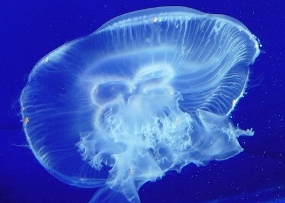 The phylogenetic position of the Scyphozoans have
been up for debate, it is unclear what the most primitive class of
Cnidarians are. Scyphozoans are known for their large size and absence of a velum. All Scyphozoans,
including Cyanea capillata,
have two phases in their life cycle: polyp (sessile) and medusa
(free living). The Scyphozoans are known as the "true
jellyfishes". Another very interesting Scyphozoan you
should take a look at is
Aurelia aurita, commonly known as the Moon
jelly.
The phylogenetic position of the Scyphozoans have
been up for debate, it is unclear what the most primitive class of
Cnidarians are. Scyphozoans are known for their large size and absence of a velum. All Scyphozoans,
including Cyanea capillata,
have two phases in their life cycle: polyp (sessile) and medusa
(free living). The Scyphozoans are known as the "true
jellyfishes". Another very interesting Scyphozoan you
should take a look at is
Aurelia aurita, commonly known as the Moon
jelly.
Order Semaeostomeae
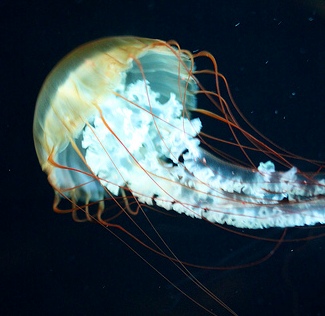 The Lion's Mane jellyfish is placed under the
order Semaeostomeae because of several characteristics. A few
basic features that define this Order are that
they lack coronal grooves, have a pedalia, and a gastric septa in
the medusa stage of their life cycle. A great example of an
organism in this order is the Pacific Sea Nettle.
The Lion's Mane jellyfish is placed under the
order Semaeostomeae because of several characteristics. A few
basic features that define this Order are that
they lack coronal grooves, have a pedalia, and a gastric septa in
the medusa stage of their life cycle. A great example of an
organism in this order is the Pacific Sea Nettle.
The phylogenetic tree above was created through PNAS by Audrey Springer and Diane Sullenberger. This phylogeny is based on rDNA sequences used to identify molecular phylogenetic species.
Family Cyaneidae
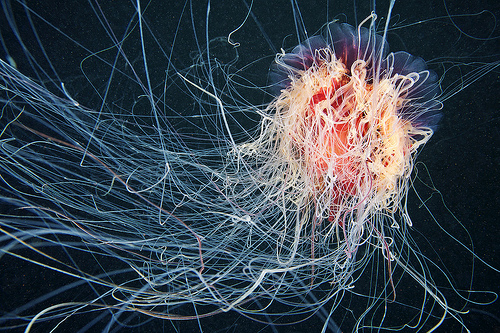 A few characteristics that
the Lion's mane has that places it under the family Cyaneidae are
that the stomach (with radiating pouches) divides into numerous
branches of canals ending in marginal lappets,
without a ring canal, complex gonads, and also the tentacles
arise with some distance from the margin. The Image on the
right is a Cyanea capillata, and is one of two well known
jellyfish in the family Cyaneidae.
A few characteristics that
the Lion's mane has that places it under the family Cyaneidae are
that the stomach (with radiating pouches) divides into numerous
branches of canals ending in marginal lappets,
without a ring canal, complex gonads, and also the tentacles
arise with some distance from the margin. The Image on the
right is a Cyanea capillata, and is one of two well known
jellyfish in the family Cyaneidae.
Genus Cyanea
 The taxonomy of the genus
Cyanea is not agreed
upon. Some feel that all of the species should be treated as one, but most
agree that at least the Lion's Mane jellyfish and the Blue
jellyfish are distinct species because of DNA testing. The
picture on the left is a Blue jellyfish, which is the only other
well studied jellyfish in the genus Cyanea. If you are find
blue organisms fascinating you should
check out
Dendrobates azureus (Blue
poison dart frog)!
The taxonomy of the genus
Cyanea is not agreed
upon. Some feel that all of the species should be treated as one, but most
agree that at least the Lion's Mane jellyfish and the Blue
jellyfish are distinct species because of DNA testing. The
picture on the left is a Blue jellyfish, which is the only other
well studied jellyfish in the genus Cyanea. If you are find
blue organisms fascinating you should
check out
Dendrobates azureus (Blue
poison dart frog)!
Species Cyanea capillata
 Cyanea
capillata has several common names around the world: Lion's Mane jellyfish, Winter
jellyfish, Sea Bubbler, and the
Hair jellyfish. The first part of its name "Cyanea"
means two rocky islands in Latin. But the name Lion's
Mane and Hair jellyfish more likely came from the many long hair like
tentacles, which makes sense, because the Latin meaning of
capillata is long hair
To the right of this text,
you can see an image of the Cyanea capillata's
tentacles at a great angle! If you only like the Lion's Mane jellyfish
because of its name, you should check out the incredibly
venomous
Lion Fish.
Cyanea
capillata has several common names around the world: Lion's Mane jellyfish, Winter
jellyfish, Sea Bubbler, and the
Hair jellyfish. The first part of its name "Cyanea"
means two rocky islands in Latin. But the name Lion's
Mane and Hair jellyfish more likely came from the many long hair like
tentacles, which makes sense, because the Latin meaning of
capillata is long hair
To the right of this text,
you can see an image of the Cyanea capillata's
tentacles at a great angle! If you only like the Lion's Mane jellyfish
because of its name, you should check out the incredibly
venomous
Lion Fish.
Are you lost? Go back to my Home page!
